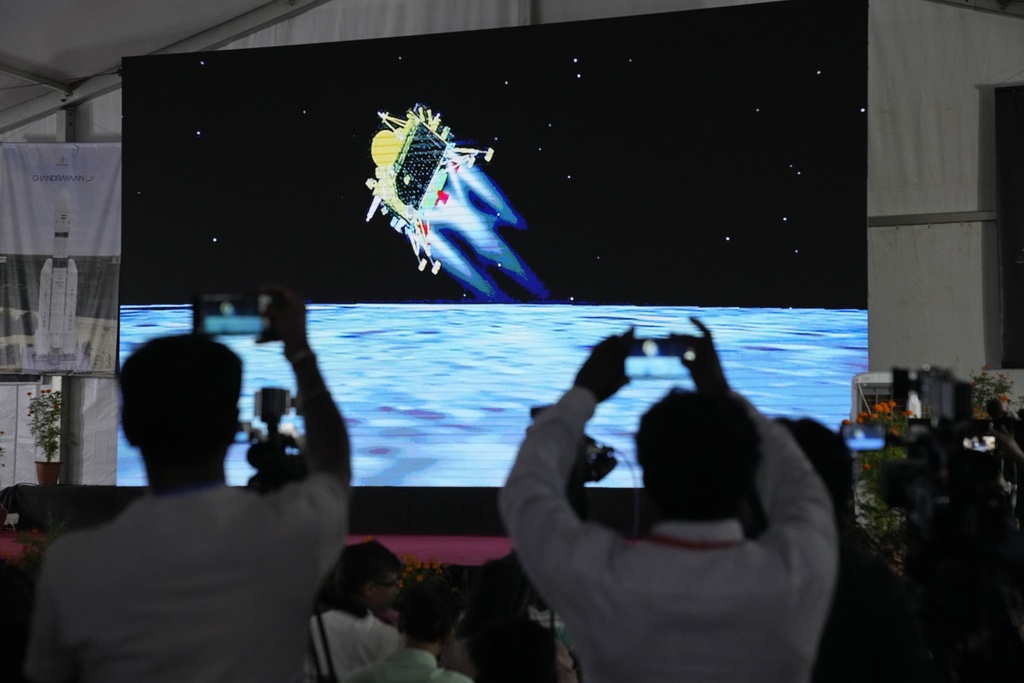India on Wednesday made history as it became the first country in the world to land its spacecraft near the moon’s south pole, an uncharted territory that scientists believe could hold vital reserves of frozen water, and the fourth country to achieve a moon landing.
A lander with a rover inside touched down on the lunar surface at 6:04 local time, sparking cheers and applause among the space scientists watching in the southern Indian city of Bengaluru. After a failed attempt in 2019, India now joins the United States, the Soviet Union and China in reaching this milestone.
Indian Prime Minister Narendra Modi watched the historic landing from South Africa, where he is participating in the BRICS nations summit. “India is now on the moon. India has reached the south pole of the moon — no other country has achieved that. We are witnessing history,” Modi said as he waved the Indian tri-colored flag.
India’s successful landing comes just days after Russia’s Luna-25, which was aiming for the same lunar region, spun into an uncontrolled orbit and crashed. It would have been the first successful Russian lunar landing after a gap of 47 years. Russia’s head of the state-controlled space corporation Roscosmos attributed the failure to the lack of expertise due to the long break in lunar research that followed the last Soviet mission to the moon in 1976.
Excited and anxious, people across India, home to the world’s largest population, crowded around televisions in offices, shops, restaurants and homes. Thousands prayed Tuesday for the success of the mission with oil lamps on the river banks, temples and religious places, including the holy city of Varanasi in northern India.
India’s Chandrayaan-3 — “moon craft” in Sanskrit — took off from a launchpad in Sriharikota in southern India on July 14.
“India’s pursuit of space exploration reaches a remarkable milestone with the impending Chandrayaan-3 Mission, poised to achieve a soft landing on the lunar surface. This achievement marks a significant step forward for Indian Science, Engineering, Technology, and Industry, symbolizing our nation’s progress in space exploration,” the Indian Space Research Organization said in a statement earlier on Wednesday.
It said that a successful Chandrayaan-3 landing would be monumental in fueling curiosity and sparking a passion for exploration among youth. “It generates a profound sense of pride and unity as we collectively celebrate the prowess of Indian science and technology. It will contribute to fostering an environment of scientific inquiry and innovation,” the organization said.
Many countries and private companies are interested in the south pole region because permanently shadowed craters may hold frozen water that could help future astronaut missions.
The six-wheeled lander and rover module of Chandrayaan-3 is configured with payloads that would provide data to the scientific community on the properties of lunar soil and rocks, including chemical and elemental compositions.
India’s previous attempt to land a robotic spacecraft near the moon’s little-explored south pole ended in failure in 2019. It entered the lunar orbit but lost touch with its lander, which crashed while making its final descent to deploy a rover to search for signs of water. According to a failure analysis report submitted to the ISRO, the crash was caused by a software glitch.
The $140-million mission in 2019 was intended to study permanently shadowed moon craters that are thought to contain water deposits and were confirmed by India’s Chandrayaan-1 orbiter mission in 2008.
With nuclear-armed India emerging as the world’s fifth-largest economy last year, Modi’s nationalist government is eager to showcase India’s rising standing as a technology and space powerhouse. A successful moon mission dovetails with Modi’s image of an ascendant India asserting its place among the global elite and would help bolster his popularity ahead of a crucial general election next year.
The anticipation for a successful landing rose after Russia’s failed attempt and as India’s regional rival China reaches for new milestones in space. In May, China launched a three-person crew for its orbiting space station and hopes to put astronauts on the moon before the end of the decade. Relations between India and China have plunged since deadly border clashes in 2020.
Numerous countries and private companies are racing to successfully land a spacecraft on the lunar surface. In April, a Japanese company’s spacecraft apparently crashed while attempting to land on the moon. An Israeli nonprofit tried to achieve a similar feat in 2019, but its spacecraft was destroyed on impact.
Japan plans to launch a lunar lander to the moon over the weekend as part of an X-ray telescope mission, and two U.S. companies also are vying to put landers on the moon by the end of the year, one of them at the south pole. In the coming years, NASA plans to land astronauts at the lunar south pole, taking advantage of the frozen water in craters.
(AP)











2 Responses
A major achievement. India (more a region than a country) was a world leader is industry and science in the 17th century, and is anxious to prove its making its way in world of 600 years of foreign rule (first by a dynasty of Muslim Persian-speaking Mongols, then by the Brits who deliberately trashed the economy).
fools, Hashem asked to plant a garden on earth and not in the sky which belongs all to him as well as at the earth….with souls starving your search the skies like foolish diseased minds…..it is all about EARTH….why a GARDEN,,….you can’t eat from the moon but you can eat what you plant…stupid Christian Era and worse, Esau was a an hateful and nasty individual and so is the Christian Race….2023 years proves it.